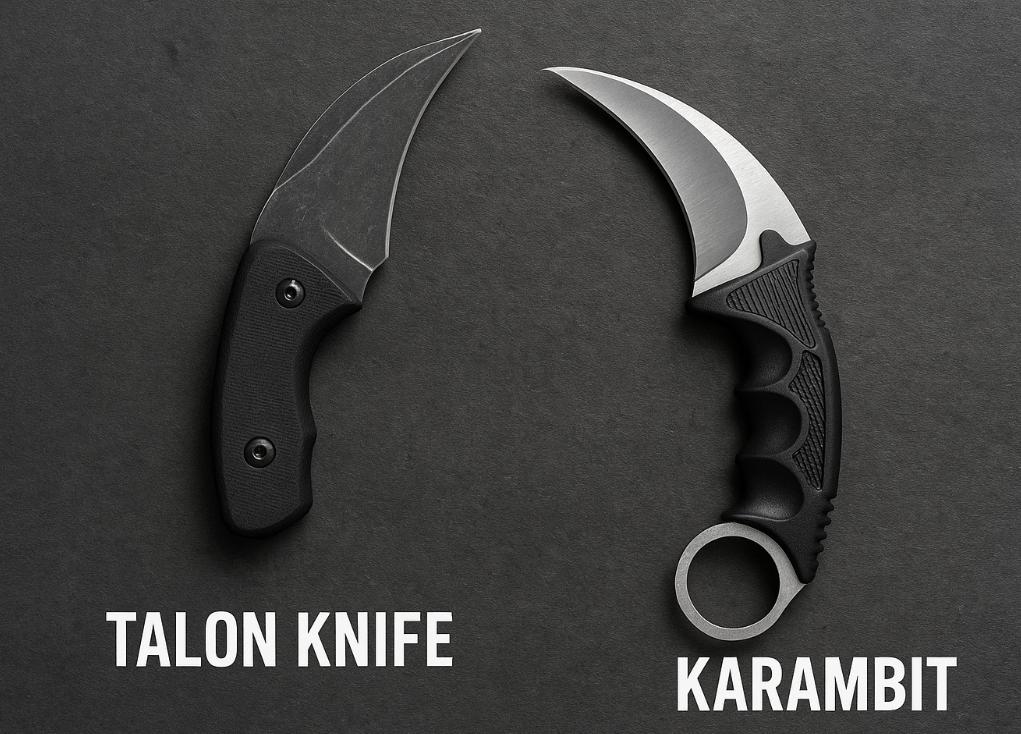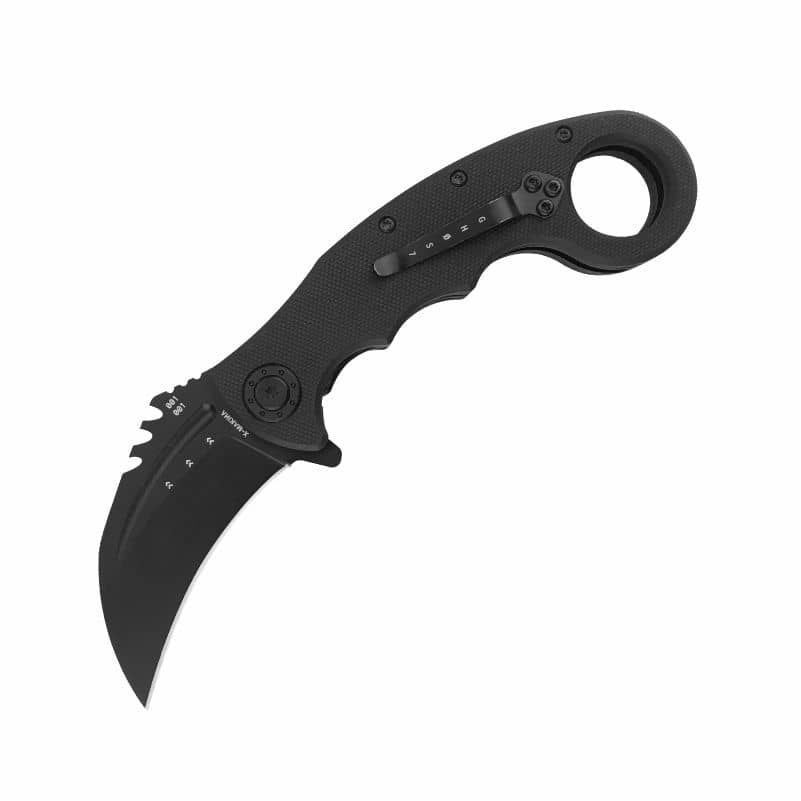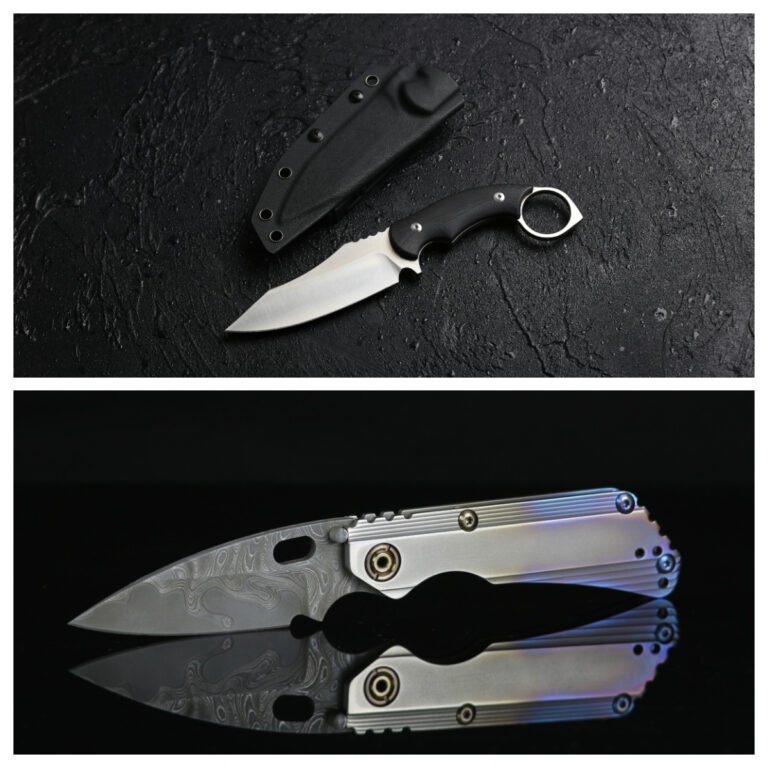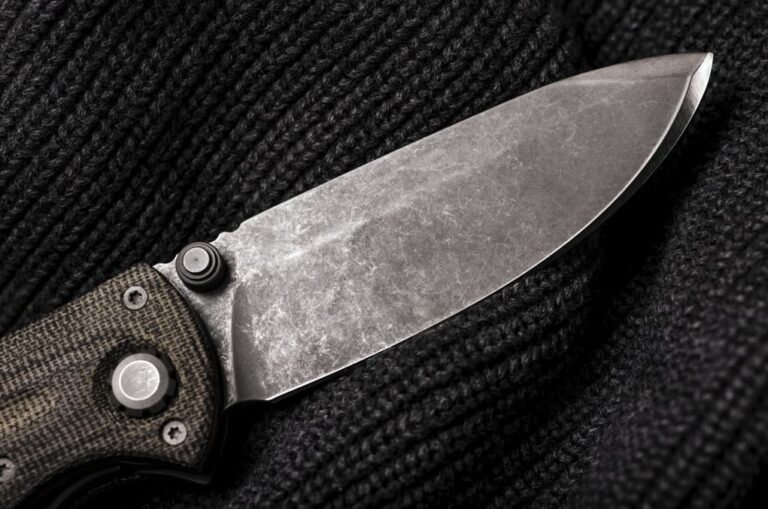When it comes to curved-blade knives, few designs capture as much attention as the Talon Knife and the Karambit. Both feature that distinctive claw-like shape, giving them an intimidating yet elegant look that appeals to collectors, martial artists, and gaming fans alike.
At first glance, these two knives may appear almost identical — both curved, sleek, and razor-sharp. However, their origins, purpose, and functionality tell two very different stories.
In this guide, we’ll break down the real differences between the Talon Knife and the Karambit, compare their performance, and help you decide which one better fits your needs.
Core Question: Is a Talon Knife a Karambit?
The short answer is no. A Talon Knife is not a Karambit—nor is it a direct descendant.
The Karambit is a traditional Indonesian and Filipino knife, originally designed as a farming tool for cutting vegetation. Over centuries, it evolved into a defensive weapon, commonly used in Southeast Asian martial arts like Silat and Kali.
The Talon Knife, on the other hand, is a modern reinterpretation of the Karambit. It borrows the same claw-like curve but comes from a contemporary, often Western or tactical design background. The Talon Knife became especially popular thanks to video games such as CS:GO, where it’s featured as a collectible, stylized weapon.
So, while the Talon Knife is inspired by the Karambit, it is not a traditional Karambit.
Buy Wholesale Knives and Start Scaling up with Us Today
Contact us and connect with a sales rep to get a free quote.
Talon Knife vs Karambit: Key Differences (Detailed Comparison)
Origin & Historical Background
- Talon Knife: A modern design concept, inspired by the Karambit but created for tactical, collectible, or aesthetic purposes. It has no cultural or traditional background.
- Karambit: Originates from Indonesia and Malaysia, with centuries of history. Initially used as an agricultural tool, it transitioned into martial arts weaponry.

Blade Shape & Design
- Talon Knife: Features a moderate, eagle-claw-inspired curve. The edge is often straight or slightly curved, with varied tip styles. Blade lengths typically range from 2.5 to 4 inches, optimized for balance between utility and portability. It rarely includes a finger ring.
- Karambit: Boasts a sharp, tight tiger-claw curve with an inward-curving edge. The tip is needle-sharp for hooking and tearing, and the defining feature is a small finger ring near the hilt. Blade lengths are shorter (2 to 3 inches), designed for quick, close-range movements in combat.
Blade Material
- Talon Knife: Uses high-performance modern steels. Popular choices include CPM S30V (for balance of sharpness retention and corrosion resistance), M390 (premium wear resistance), and D2 tool steel (affordable durability). Blades may have polymer coatings to reduce friction and prevent rust.
- Karambit: Traditional models use 1095 high-carbon steel (easy to sharpen, excellent edge retention) while modern versions adopt stainless steels like 440C. Many handcrafted Karambits feature Damascus steel for aesthetic appeal, though functionality remains focused on combat agility.
Buy Wholesale Knives and Start Scaling up with Us Today
Contact us and connect with a sales rep to get a free quote.
Handle Design

- Talon Knife: Prioritizes ergonomics and modern utility. Handles are made from G-10, Micarta, titanium, or anodized aluminum, with textured grips for non-slip performance. Most models include SpeedSafe assist-open mechanisms, pocket clips for EDC carry, and lock systems (like liner locks) for safety. Some add glass breakers for emergency use.
- Karambit: Focuses on secure grip during combat. Handles are compact, made from wood, bone, or modern composites, and always include a metal finger ring. The ring prevents the knife from slipping during rapid strikes or grapples, a critical feature for close-quarters defense. Traditional models lack clips or assist-open tools.
Opening Mechanism
- Talon Knife: Dominated by folding designs. Most use assist-open systems (SpeedSafe, thumb studs, or flippers) for quick deployment—ideal for tactical scenarios or EDC tasks like opening packages. Some high-end models offer automatic opening (double-action autos) for instant access.
- Karambit: Mostly fixed-blade or simple folding designs. Fixed-blade Karambits are full-tang for strength, while folding versions use basic slip joints or liner locks. No assist-open mechanisms are included, as traditional design prioritizes stability over speed.
Buy Wholesale Knives and Start Scaling up with Us Today
Contact us and connect with a sales rep to get a free quote.
Primary Uses
- Talon Knife: Versatile across multiple scenes. It excels at tactical missions, EDC tasks, outdoor survival, and emergency rescue.
- Karambit: Specialized for close-quarters combat and martial arts. It’s used in Silat training, self-defense, and historical reenactments. Traditional models also hold cultural significance in Southeast Asian ceremonies, while modern versions are popular among collectors.
💡 Note:
In some regions, ringed knives like the Karambit are classified as restricted weapons. Always check your local laws before carrying one in public.
Legal Status
- Talon Knife: Generally legal in most regions. Legality depends on blade length (most places allow blades under 4 inches) and opening mechanism—automatic Talon Knives are restricted in some U.S. states and European countries. It’s EDC-friendly when compliant with local laws.
- Karambit: More strictly regulated. Due to its combat-focused design and finger ring, it’s classified as a “dangerous weapon” in many areas. Public carry is prohibited in most U.S. states, the EU, and Asia. It’s often limited to martial arts training or collection.
Pros & Cons: Talon Knife vs Karambit
Talon Knife
- Pros:
- Versatile: Works for tactical use, EDC, outdoor adventures, and emergencies.
- Modern safety features: Lock systems and non-slip grips reduce injury risk.
- Durable materials: High-performance steels resist wear and corrosion.
- Legally safer – Usually falls under the “utility knife” category, making it easier to own or carry in many regions.
- Cons:
- Less specialized for close combat compared to Karambit.
- Auto-open models face legal restrictions in some regions.
- May be overkill for simple EDC tasks.
Karambit
- Pros:
- Superior for close-quarters defense: Finger ring and curved blade enable quick, effective strikes.
- Lightweight and compact: Easy to conceal for self-defense (where legal).
- Traditional craftsmanship: Handmade models have high collector value.
- Durable fixed-blade options: Full-tang design handles heavy use.
- Cons:
- Limited utility: Not ideal for EDC, bushcraft, or general tasks.
- Finger ring poses accidental injury risk (especially for beginners).
- Strict legal limits: Public carry is mostly prohibited.
- Steeper learning curve for safe use.
Which One Should You Choose?
Choosing between a Talon Knife and a Karambit depends on your purpose:
- 🥋 For martial arts or self-defense training:
The Karambit is the better choice. It’s designed for control, precision, and tactical movements — but it requires proper training. - 🧭 For casual use or collection:
The Talon Knife is more versatile and easier to handle. It’s perfect for display, everyday cutting tasks, or as a stylish addition to your EDC gear. - ⚖️ For legal or safety reasons:
Always verify your local laws. In many areas, curved or ringed knives may be considered combat weapons and not suitable for public carry.
Buy Wholesale Knives and Start Scaling up with Us Today
Contact us and connect with a sales rep to get a free quote.
Frequently Asked Questions
Can I use a Talon Knife as a Karambit for self-defense?
While a Talon Knife can be used for self-defense, it’s not as effective as a Karambit. The Karambit’s tight curve and finger ring are optimized for close-range strikes and grapples, while the Talon Knife’s moderate curve and utility-focused design make it better for general tasks.
Are all Karambits illegal to carry?
No, but most are restricted. Legal status varies by region—some places allow Karambit for martial arts training (with a permit) but prohibit public carry. Always check local laws before purchasing or carrying a Karambit.
Do Talon Knives have the finger ring like Karambits?
Almost never. Talon Knives prioritize utility over combat, so they don’t include the finger ring. The few exceptions are niche models inspired by Karambit, but they’re not standard.
Which blade (Talon Knife vs Karambit) holds a sharper edge longer?
It depends on the steel. Talon Knives with CPM S30V or M390 steel hold edges longer than traditional Karambits with 1095 carbon steel. Modern Karambits with 440C stainless steel offer similar edge retention to mid-range Talon Knives.
Is a Karambit more dangerous than a Talon Knife?
Yes, due to its design. The Karambit’s sharp curve, needle tip, and finger ring make it more lethal in close combat. Talon Knives are dangerous but less specialized for harm, with safety features to reduce accidental injury.
Conclusion
Both the Talon Knife and the Karambit share the same claw-inspired elegance, yet they serve different purposes. The Karambit stands as a symbol of tradition, technique, and martial heritage — ideal for those who appreciate control, precision, and cultural depth. The Talon Knife, on the other hand, offers a modern take on curved-blade design, balancing practicality, style, and versatility for everyday use or tactical appeal.
If you’re a knife enthusiast, retailer, or brand owner deciding between the two, the choice ultimately depends on your purpose, market, and audience. And if you’re ready to turn that choice into action — whether sourcing Talon Knives, Karambits, or custom designs — Leeknives is here to help. We’re a professional Chinese knife manufacturer offering wholesale supply, OEM, and private label services for partners across Europe and North America. Backed by quality craftsmanship and reliable export experience, we help you create knives that stand out in your market.
👉 Request your free quote today and start sourcing premium knives directly from China








